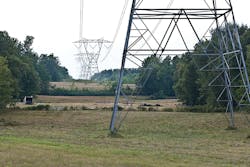Pasture Protection: Grazing Tolerances on Herbicides Protect Pastures
When applying herbicides on utility rights-of-way (ROW), utility vegetation managers must read and understand product label information regarding grazing tolerances. Failure to do so can lead to unintended consequences such as off-target crop damage and the rejection of livestock for human consumption.
In a nutshell, any herbicide that is applied to land — including utility ROW — that is subsequently used for grazing must have grazing tolerances spelled out on the label. Land that is treated with herbicides lacking grazing tolerances puts the livestock who graze that land and the products of the livestock — milk, dairy products or meat — at risk of being rejected, economically impacting landowners, ranchers or farmers.
Grazing tolerances are established for a herbicide by the U.S. Environmental Protection Agency. They are only established for products that have undergone stringent testing for use of the herbicide on grass, hay or other feedstock for livestock animals such as cattle, horses, sheep and goats. Products with grazing tolerances also may have certain grazing restrictions, which are listed on the product label. Applicators are required to read, understand and comprehend all herbicide labels prior to mixing, handling or applying.
No Switching Needed
A herbicide that contains grazing restrictions on its label means that the product can be used to treat vegetation in grazed areas, but vegetation managers must still abide by any special-use restrictions on the label. These restrictions could apply to use rates, application methods, or how to handle hay, manure or the movement of livestock in and out of the treated areas. Violations of the herbicide label conditions of use is considered an off-label application under the Federal Insecticide, Fungicide and Rodenticide Act and is typically adjudicated by the state Department of Agriculture, with civil or criminal penalties possible. There are many cases where large settlements have been paid out to replace contaminated livestock.
Using herbicides with grazing tolerances is similar to using herbicides registered for both aquatic and terrestrial use when making an application. When a herbicide has both aquatic and terrestrial labeling, vegetation managers and applicators are able to treat entire ROW — even when encountering creeks, streams and wetlands — instead of having to switch from a terrestrial herbicide to an aquatic herbicide. A similar scenario exists for vegetation managers and applicators using a herbicide with grazing tolerances. They are able to treat the entire ROW without having to switch herbicides or herbicide mixtures, even when the ROW contains both nongrazing and grazing areas.
Best Practices
The definition of grazed areas is also somewhat broad. It mainly refers to pasture or rangeland set aside for grazing cattle or other livestock. Since ROW often cross these areas, vegetation managers are charged with managing at least their portions of these sites. When managing vegetation in these areas, it is most efficient if the products to be used are labeled for as wide a variety of sites as possible along the ROW.
Typically there is no cost difference or additional premium for the grazing tolerances on a herbicide, and herbicides with grazing tolerances are easily accessible from most herbicide manufacturers.
It is important to note that even if an animal escapes from a fenced-in pasture and grazes an area treated with a herbicide without a grazing tolerance, that animal may be considered adulterated and cannot be sold for food.
Though it is currently not a standard and universal practice, grazing tolerances should always be considered when planning herbicide applications and performing herbicide auditing. When planning an application, the utility and applicator should assess the amount of land that might be grazed on ROW to be treated, both bringing the issue of grazing tolerances to the applicator’s attention as well as setting out parameters for the application, minimizing post-application confusion. In addition, utilities could state in bid packages that only products with grazing labels will be accepted for use.
It is also a good policy for utilities to practice proactive landowner communication prior to herbicide application, especially in areas where grazing may be taking place. This helps alleviate landowner concerns, but also provides a forum for landowners to alert utilities to areas susceptible to grazing animals.
Scott Wright is the IVM product manager for Dow AgroSciences. Previously, he was a sales specialist for the company’s Eastern Vegetation Management District, serving the states of Mississippi and Arkansas. Wright also served as a research associate at Mississippi State University, working extensively with Euel Coats and John Byrd, both nationally renowned weed science experts. Wright is a past board member and president of the Mississippi Vegetation Management Association and a current member of the Utility Arborist Association.

